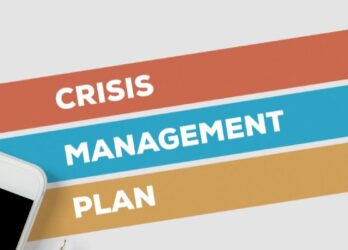Last updated on March 7, 2024 at 10:48 am
Crisis management is a huge part of an internal communicator’s role. So, why do we sometimes put off creating plans for the next company crisis?
Whether it’s a global crisis or something local to our company—such as layoffs, CEO changes, or economic impacts—we have to be ready. That means not waiting until we think the time is “right” to implement new tools, train managers on communication, or initiate stronger collaboration cross-functionally. The time to show your employees how important they are to your organization is now.
What is a company crisis?
One of the main reasons why many companies put off creating crisis communication plans is because they don’t realize how common crises can occur. A company crisis isn’t just something as big as the COVID-19 pandemic. It can also be changes to your C-suite, economic pressures, or natural disasters.
Essentially, any event that causes a major disruption to your business is a company crisis.
When you look at business crises through this lens, you begin to realize how common they are. And the more prepared you are for various scenarios, the more you can mitigate the damage.

What is an example of a company crisis?
One of the most common examples of a company crisis is layoffs. Although these are planned events, which a company does purposefully to keep their businesses running, they technically are a crisis. Here’s why:
- Layoffs often impact the entire company. Of course, they impact those who lose their jobs, but layoffs that aren’t properly handled can also raise concerns among the rest of your employees.
- Layoffs can have an internal and external impact. Often, word will spread about companies laying off employees. At the very least, individuals who have lost their jobs will post on LinkedIn and share with their networks why they’re looking. This means that how you handle layoff communications can have an impact on your brand’s lasting reputation.
- Layoffs are almost always due to another external factor. Remember that you aren’t just laying off staff for no reason. It’s likely in response to another major change or event, such as a recession or a change in the strategic direction of the business. So when you communicate layoffs, you also have to address the root cause too.
How do you respond to a company crisis?
So, what should you do when a company crisis inevitably strikes? There are five important steps you should always take:
- Remember your values. Too often, a company crisis happens and everything we know about communicating with values and following internal branding go out the window. Remember who you are and how you communicate with your teams. This is not the moment to go rogue! And keeping your values and employee value proposition in mind when you communicate about a crisis will help you write more empathetic communications.
- Identify your stakeholders. It’s important to have meetings with all the key stakeholders who will be responsible for responding to the crisis. This ensures you’re all on the same page and know why decisions are being made.
- Start communicating as soon as possible. The longer you wait, the more nervous your people will get. Don’t worry about having all the information before you address your teams. Let them know that more information is coming and where they can go with their questions. Just, whatever you do, don’t leave your employees completely in the dark.
- Empower your managers. In any crisis, your people managers bear the brunt of the impact. Give them the resources and talking points they need to answer their teams’ questions.
- Have leadership step up. Sharing why a crisis is happening or why you’re responding a certain way is so important. And it’s critical that this is done with empathy and compassion for those impacted. But it’s also important that this message come from an executive leader. But you have to coach them, or else you might make the crisis worse.

5 Ways to Prepare for a Company Crisis
After you’ve handled a crisis, and even before one has happened, it’s important to prepare. These five tips will help you create a foolproof crisis communication plan.
1. Ask your frontline managers what they need.
Your employees will look to their direct managers first, and your managers want to support them with accurate and timely information. So, find out:
- What format do your managers want to receive communication?
- Which day of the week is best for weekly updates?
- What time of day is best for daily updates?
Even if you have a good sense of the answers, your managers will appreciate being asked for their preferences and even more that you listen and make adjustments.
Once you have their input, make sure you’re taking all the right steps to help them communicate effectively. Our guide to frontline manager communication can help.
2. Conduct a start, stop, and continue evaluation.
Look back at what you’ve done when communicating about crises in the past. Look at any other crises your company weathered these past few years. And honestly evaluate the effectiveness of each crisis plan.
- What should you start doing based on employee feedback and the current state of the business?
- Is there anything you should stop doing because it was not effective and your employees will expect a pivot in strategy?
- What do you need to continue doing because it’s what your employees both want and need right now?
A Stop, Start, Continue Analysis will help you stay agile and flexible in your strategy and maintain focus on the employee experience.
3. Regularly communicate employee feedback and engagement levels with leadership.
Any decisions that are happening in the boardroom should have employee voices represented. Ensure that leaders know what employees want and need from the company so that decisions can be made with full awareness of the employee experience.
During any crisis, your executive team is going to set the tone and the example for the whole company. If they’re able to show employees that they understand how they are feeling and what they need, you’re more likely to assuage fears and concerns.
And make sure that those leaders are able to reach your deskless workforce as well. We recommend using video since the leadership team can’t always travel to all your facilities to deliver updates.
Watch this short video for our top tips on creating executive leadership videos.
4. Be transparent, genuine, and empathetic in your crisis communication.
People are upset, anxious, and overwhelmed during a company crisis. Employees want to know that the company has some level of understanding of these emotions and their impact on performance and engagement.
This doesn’t mean completely dropping expectations for productivity, customer service, or upholding safety standards. But it does mean communicating those expectations in a way that makes employees feel important and essential to the business’s success, the experience of their customers or patients, and their peers. It means saying to your employees, “it’s ok to not be ok and we’re here to help however we can.”
5. Don’t wait to plan company crisis communication.
Although times of uncertainty and crisis might not seem like the best time to conduct your internal comms audit, adopt a new tool, or make a change. It’s exactly the right time. When the pandemic began, you likely discovered many gaps in your strategy or crisis communication plan that you didn’t know existed.
- Were you able to reach everyone?
- Were you able to engage furloughed/remote workers?
- How did you manage the morale of frontline employees who felt more sacrificial than essential?
- What support did they need that you couldn’t provide?
Most likely, there were gaps in your strategy or your ability to reach all your people. That’s exactly why now is the time to act. Using an audit can be a great way to start creating a crisis preparation and recovery plan.
Internal communicators are some of the most resilient and adaptable professionals I know. You know how to make an impact through communication. You have the power to activate your employees with your content. As long as you clearly define the action you are aiming to initiate because of your words, you will deliver what your employees want and need during the next crisis.
If you need help reaching your frontline employees, we can help.
About the Author
Amy Jenkins is theEMPLOYEEapp’s Director of Client Strategy & Success. With over ten years of experience working in internal communication, Amy helps our clients create mobile communication strategies that get results.
Subscribe To The theEMPLOYEEapp Newsletter
Comments are closed.





